The cross is the historic symbol of the Christian Faith.
Crosses are seen on churches, in jewelry, and in many other materials. They are made by human hands, and have no intrinsic power, but they are no ordinary symbol for the Christian. The cross has inspired many to be faithful to God.
We know that not everyone who looks at a cross understands the true meaning of the Cross of Christ. We discover the meaning of the cross in the message of the cross, and that message is the atonement.
The nature of God, Himself, is the source of the atonement. God is indivisible with regard to His being and attributes. He is at the same time holy, righteous, merciful, and loving, among many other attributes.
As holy and righteous, God acts justly in judging sin, and His response to it is to pour out His wrath on it.
As loving, He acts sacrificially and mercifully to satisfy His holiness and justice and assume the penalty for our sin and guilt. He did just that in the death (and resurrection) of Jesus Christ.
The atonement was a work of love. Rom. 5:8 states that, “God demonstrated His love for us in that while we were yet sinners, Christ died for us.” John 3:16 and I John 4:9-10 also attest to God’s purpose of love in the atonement “. . .This is love: not that we loved God, but that He loved us and sent His Son as an atoning sacrifice for our sins.” (NIV) The work and act of Christ on the cross was an act of God’s holy love.
The atonement was an act of divine justice and righteousness. Even we humans expect penalties to be paid for offenses, violations and wrongs. Humans are indignant to some sin and wrong, but our inclination is to indulge in it rather than recognize its gravity. Our response to sin is fallen and inadequate, while God’s is perfect and just.
The atonement was an act of redemption. The Old Testament introduces us to the practice of God’s people of offering sacrifices for the atonement of sins, which lead to the restoration of the relationship of the sinner with God.
Jesus quoted from Isaiah 53 and related His atoning death to this sacrifice in Luke 22:37 not long before his crucifixion saying, “For I tell you that this which is written must be fulfilled in Me, ‘AND HE WAS NUMBERED WITH TRANSGRESSORS’, for that which refers to Me has its fulfillment.” (NASB)
The New Testament presents the full understanding of the atonement. It was a divine work to redeem and restore people to God. (I Pet. 2:24; 3:18) Rev. 5:9 explains that, “Worthy are You to take the book and to break its seals; for You were slain, purchased for God with Your blood men from every tribe and tongue and people and nation.” (NASB) The blood represents His life sacrificed, penalty paid, and the redemption of people who are guilty before God and separated from Him by their sin. (I Pet. 1:18-19) From the Scriptures, we then confess that it is Jesus who “by His own blood obtained eternal redemption for the believer.” (BF&M Article IV on Salvation)
Here is the meaning of the message of the cross: On behalf of sinners, Jesus Christ, the sinless Son of God, became our substitute on the cross. He willingly suffered, was crucified, and died in our place, paid our penalty, and bore our sin and guilt, in an incomparable act of mercy and love, to offer us forgiveness and salvation. (John 10:11, 17-18) When you look at a cross, think about that meaning.





